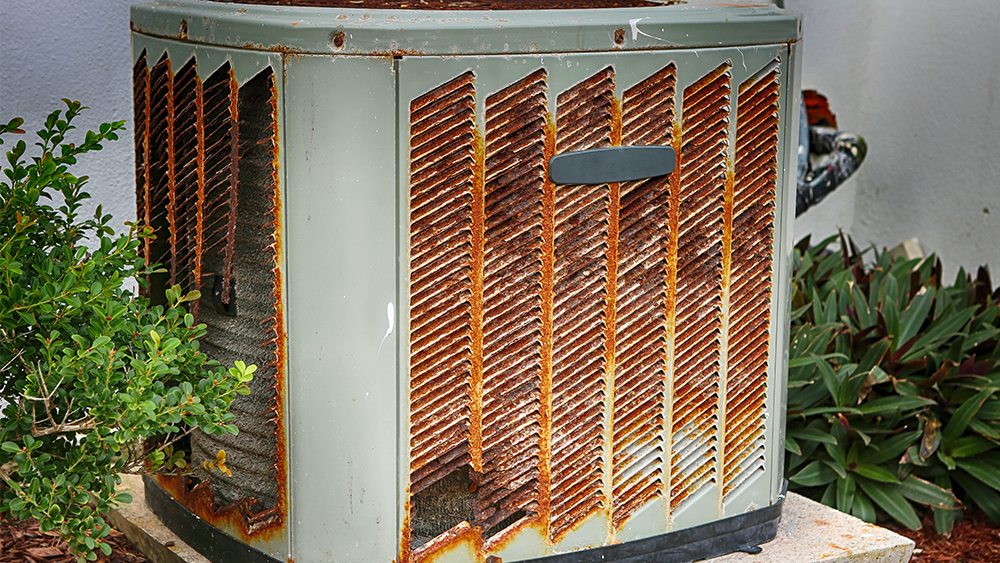1. Moisture Intrusion:
Because moisture is metal’s worst enemy, it’s inevitable that rust will form if it gets into the AC unit or furnace. External elements, including ventilation system leaks or poorly sealed ducting, are usually the main culprits when it comes to moisture penetration. Any opening, no matter how little, can let water vapour in, setting off a corrosion battle with the metal parts.
During temperature variations, condensation can form inside the unit, which is another form of moisture. Rust may develop when warm air comes into contact with cold surfaces, as this causes the formation of water droplets. Combating corrosion caused by moisture becomes more difficult in areas with high humidity, making this a more pressing issue in such areas.
To keep moisture out, check the HVAC system often, fix any obvious leaks right once, and make sure there’s enough insulation to prevent condensation. To further control indoor humidity levels and lessen the likelihood of rust formation, dehumidifiers can be effectively installed.
2. Chemical Corrosion:
Many different chemicals are used in the complex machinery of air conditioners and furnaces to make them work better. The problem is that some of these compounds might actually accelerate corrosion if not addressed. Combustion by-products from furnaces, for instance, are acidic and can gradually corrode metal surfaces.
In the same way, improperly maintained refrigerants in air conditioning systems can lead to corrosion. The rusting process might be accelerated by the released chemicals when refrigerant leaks, which happens frequently in older systems. Rust can also develop on coils that have accumulated dirt and debris, which creates a corrosive environment.
The best defence against chemical corrosion is routine maintenance. Heating, ventilation, and air conditioning (HVAC) experts can find problems early on through scheduled inspections. Important procedures to prolong the life of these systems include cleaning and replacing filters, checking the efficiency of combustion, and fixing refrigerant leaks quickly.
3. Poor Quality Materials:
Rust can sometimes be caused because of the materials used to build furnaces and air conditioners. These systems are susceptible to the constant attack of environmental elements because they are made of low-quality metals or have inadequate protective coatings. The gradual degradation of the unit begins with unseen symptoms, but once rust becomes a problem, it weakens its structural integrity.
The HVAC system’s appearance and performance are both compromised when manufacturers compromise on material quality, which can cause rusting to occur early. The problem is most noticeable on the outside, where parts like the housing, vents, and screws are located.
You may reduce the chances of poor material quality in HVAC equipment by buying well-known brands and doing some research before you buy. To further guard against rust, you might treat or coat susceptible parts with protective materials.
4. Environmental Exposure:
The corrosion process is very susceptible to environmental factors. Rust is more likely to form on furnaces and air conditioners that are placed in places with severe weather, including as near the coast where the air is salty or places with a lot of pollution. In instance, salt has an additive impact on corrosion because it encourages the oxidation of metal surfaces.
Sulphur compounds and industrial emissions are among the airborne contaminants that might hasten the HVAC system’s deterioration. When these contaminants are mixed with water, they create corrosive agents that erode the metal’s protective coatings. Rust can develop from this kind of exposure over time, weakening the unit’s structural integrity.
Protective coatings and frequent cleaning are necessary to lessen the effects of environmental exposure. You may greatly lessen the likelihood of rust by cleaning the outside surfaces of the HVAC unit to eliminate contaminants and salt deposits. Coatings and paints that resist corrosion can also serve as a barrier, protecting metals from environmental corrosives.
5. Neglected Maintenance:
Doing nothing to prevent rust is like inviting it in with an open invitation. Furnaces and air conditioners get dirty and clogged with dust and other particles over time. These particles can trap moisture and foster the growth of rust if not addressed. Corrosion of internal components and decreased system performance are both caused by clogged vents and air filters.
Cleaning, lubricating moving parts, and replacing worn-out filters are essential maintenance procedures that help prevent rust. To maximize heat exchange and minimize the possibility of rust due to moisture, clean the coils and remove dirt from important places. In addition to hastening rust formation, skipping these maintenance tasks reduces system efficiency and increases energy usage.
Proactive homeowners engage in professional HVAC inspections and stick to the maintenance schedules recommended by manufacturers. Equipment longevity and protection from the constant rust danger are both enhanced by regular cleaning and other preventative actions.
6. Improper Installation:
When it comes to keeping HVAC systems rust-free, the significance of a proper installation is essential. The corrosion process can begin when moisture penetrates into devices due to improper installation, which can cause gaps, loose connections, or poor sealing. Furthermore, certain regions may be more susceptible to rust and structural stress as a result of unequal weight distribution, which can be caused by sloppy installation procedures.
It is critical to have trained technicians install HVAC devices in accordance with established procedures. To keep moisture out, make sure the ducts are properly sealed, make sure the connections are secure, and install enough insulation. To extend the life of the system and make it resistant to rust, make sure there is enough airflow around it and follow all local building requirements.


